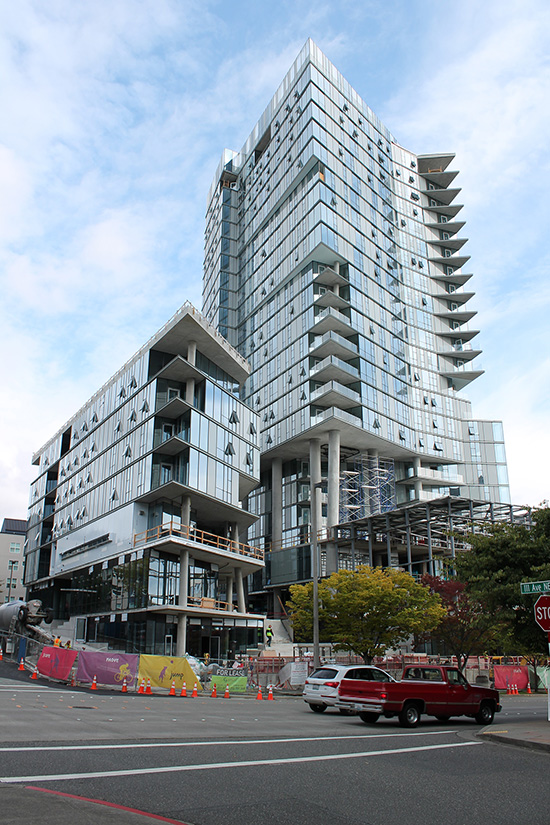|
Subscribe / Renew |
|
|
Contact Us |
|
| ► Subscribe to our Free Weekly Newsletter | |
| home | Welcome, sign in or click here to subscribe. | login |
Architecture & Engineering
| |
 |
October 3, 2019
Survey: Bohlin Cywinski Jackson

Specialty: Architecture, planning, interiors, design
Management: Bohlin Cywinski Jackson has nine shareholders, including two who lead the Seattle office. They are principals Ray Calabro and Robert E. Miller
Founded: 1965
Offices: Wilkes-Barre, Pennsylvania; Pittsburgh; Philadelphia; Seattle; San Francisco; New York
Revenues: N/A
Projects: Brio Tower, a 23-story, 259-unit apartment project in downtown Bellevue for Su Development; Bellevue fire station 5 and 10; Lightbox Studio, a photography studio and archival room in Point Roberts
Principal Robert E. Miller answered questions about his firm and trends and issues in the industry.
Q: BCJ got into high-rise design fairly recently. How is that going?
A: Our entry into high-rise design began in Bellevue and its successful outcome took us quickly to other cities such as Honolulu and Santa Clara, California.
Our design-first focus and strength as problem-solvers has translated well to high-rise design. We’ve found it helps to be selective and seek like-minded clients. We’ve been fortunate to partner with several clients who allow us to be part of achieving their aspirations for unique and highly profitable structures.
Q: A number of projects in Seattle are using stilt-like columns. Why are you employing them?
A: We have been developing an architectural language as we enter the high-rise market. One of our early discoveries was the power of the columns. Not only could we find efficiencies in transferring loads through sloped columns rather than expensive beams, but we could utilize those same columns to create an interesting architectural expression.
The design now invites one to meander through the columns, which read like a loose forest. This is a less traditional experience, but hopefully memorable. The effect allows for greater flexibility as we fine-tune the experience of the park extension and podium.
Q: New developments in Yesler Terrace seem light on retail, yet Su is proposing 10,000 square feet of retail/commercial space. Why that much?
A: The retail program is in development. We believe there will need to be a critical anchor at this end of the park to activate the community and the open space.
While the expansive views of the Seattle skyline, accessible ramped walkways, and a series of follies will be a large draw, we want to support the community through creating flexible spaces than can adapt as the neighborhood evolves.
One of my favorite features is a large “market hall,” which we hope will support many local startup businesses as an incubator and supplier of specialty goods based on the diverse community. We hope to embed vibrancy in the podium akin to Pike Place Market.
Q: What can architects, developers and government do to make the Puget Sound region more livable and sustainable?
A: The perceived livability in Seattle has taken a dramatic turn. I believe we need to address the issue of cost of living to effect change.
We need to invest in infrastructure that supports humane, high-quality environments in higher density, pedestrian-friendly neighborhoods. We need to combine this infrastructure with a graceful flow of people and goods to serve them effectively and efficiently.
I want to see an investment in quality design and construction to assure the Seattle of the future is one we can be proud we were part of generating. The city, architecture, and infrastructure needs to protect the environment and invest wisely in securing a net-positive restorative impact on the earth.
Q: Which sector of your firm’s work has grown the most in recent years?
A: Locally, we’ve seen growth in high-rise work. I suspect that trend will continue and that we will find innovative programs and construction techniques to keep it rewarding.
Also, recently our practice has delved into designing makerspaces for academic institutions such as Carnegie Mellon University, Kent State University and University of Illinois Urbana-Champaign. It’s a rapidly maturing typology without ample precedent, but I suspect we’ll continue to see more of this typology as institutions emphasize interdisciplinary collaboration as part of their pedagogy.
And, while we cannot predict the future, my hunch is that there will be a sizable portion of work in social good or philanthropic ventures.
Other Stories:
- Why electric scooters could be a game changer for Seattle
- CLT: construction’s lean, green beauty queen
- The AEC industry has a data problem
- What our evolving mobility options mean for designers and developers
- New OSU-Cascades academic building will aim for net zero
- Mass timber is bringing the warmth of wood to the workplace
- With so many tech advances, why has AEC productivity growth stalled?
- Survey: Cary Kopczynski & Co.
- Survey: Weber Thompson
- Survey: Johnston Architects
- These 3 Northwest projects show how listening to clients pays off
- Which project delivery methods work best?
- How understanding building codes can help you get more out of your project
- How successful workplaces offer more than just a place to work


